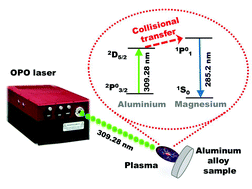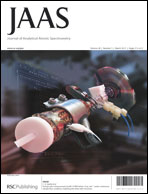Resonant laser-induced breakdown spectroscopy (RLIBS) analysis of traces through selective excitation of aluminum in aluminum alloys
Abstract
We investigated laser-induced breakdown spectroscopy for the detection of traces of magnesium and silicon contained in aluminum alloys by using the same 5 ns optical parametric oscillator laser pulse to ablate the sample and excite selectively an atomic transition of vaporized aluminum (Al I 309.27 nm). The excitation energy of aluminum is then transferred to all components of the gas/plasma phase via particle collisions. The optical emission of the trace elements as a function of the laser wavelength exhibits a high peak when the laser is tuned exactly to the aluminum transition. The on-resonance signal-to-noise ratio of magnesium (Mg 285.21 nm) was maximized near the off-resonance threshold fluence for detection of the magnesium line (∼1.78 J cm−2). The detection threshold of the magnesium line decreases below 1.0 J cm−2 when the laser is on resonance for a sample of aluminum alloy containing 150 ppm of magnesium. Under optimal conditions, the limits of detection of magnesium and silicon in aluminum alloy were found to be 0.75 ppm and 80 ppm, respectively, compared to 39 ppm and 5000 ppm, respectively, when the laser was off resonance at the same fluence. The limits of detection obtained by using low fluences and low energy per pulse are similar to those obtained using conventional


 Please wait while we load your content...
Please wait while we load your content...